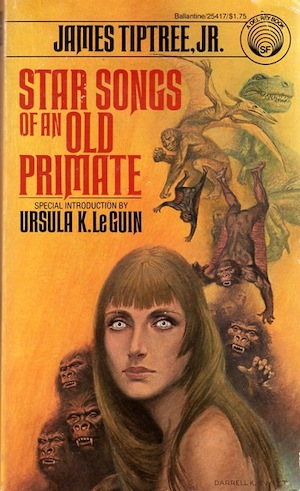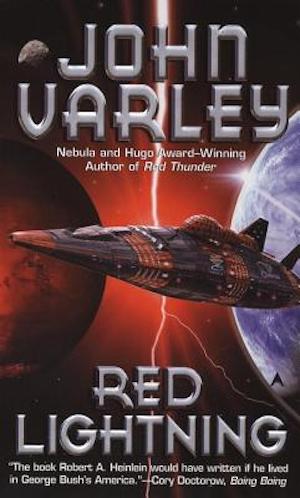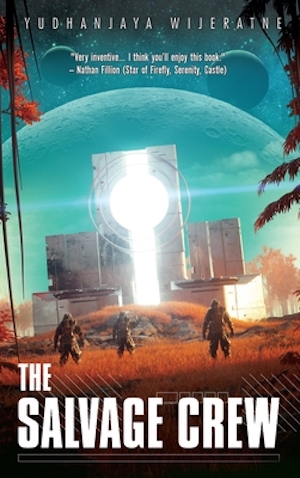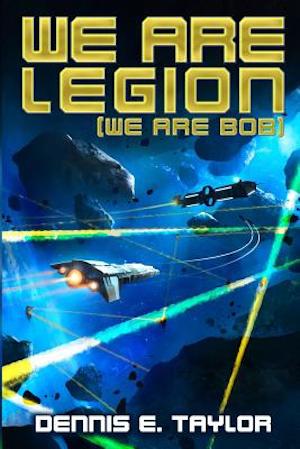I just happened to be looking at the August 1975 issue of Galaxy Magazine1 when my attention was caught by an essay: Jim Baen’s “The Myth of the Light-Barrier.” Was this yet another example of what we will polite call “relativity skepticism,” perhaps an early look at Petr Beckmann’s Galilean Electrodynamics? In short, no.2 Instead Baen celebrated the fact that a rocket capable of sustaining a one-gravity acceleration indefinitely can travel astonishing distances in a very short time from the perspective of the traveler. Of course, the stay-at-home will experience a lot more time, but Baen sees this as a plus:
And that’s the point. Given a one-gravity, constant-acceleration space-vehicle plus a complete indifference to point of origin, you can go anywhere and do anything. You can even be free. Because anybody who might have an inclination to tamper with your liberty (unless you were foolish enough to bring him along) will have been dust long before you arrive at your destination. Blue meanies included. Freedom!
This is entirely true. See the chart below (lifted without credit from a 2018 Tor.com essay by someone or other) for distances covered at one gee.
| Destination | Distance (Light Years) | Ship Time (Years) | Earth Time (Years) |
| Alpha Centauri | 4.3 | 3.6 | 5.9 |
| Tau Ceti | 11.9 | 5.1 | 13.7 |
| 40 Eridani | 16.3 | 5.7 | 18.1 |
| The Pleiades | 444 | 11.9 | 446 |
| Crab Nebula | 6,500 | 17.1 | ~6,500 |
| Galactic Core | 28,000 | 19.9 | ~28,000 |
| Andromeda Galaxy | 2,500,000 | 28.6 | ~2,500,000 |
Thanks to inconsiderate details like engineering practicalities, the rocket equation, and the irritating fact that Bussard ramjets are nine orders of magnitude more efficient at dissipating energy than they are at generating it, this table is completely irrelevant to any future that humans are likely to experience. However, just because something is impractical or even impossible has never stopped SF authors from exploring a cool idea in their fiction.
“A Momentary Taste of Being” by James Tiptree, Jr. (1975)

Four light-years from overcrowded Earth3, the Centaurus searches for a world suitable for colonization. Thus far, there has been no good news for Earth’s tens of billions. Now a promising world presents itself…but is the seemingly perfect world a trap?
Not being an idiot, the captain of the Centaurus dispatches a survey team to examine the world. Only Lory Kaye returns, bringing with her samples from the world below. Is the planet the paradise Lory claims? Or is there some darker reason why the rest of the survey team did not return?
Some readers may turn to science fiction for the reassurance and solace they do not find in life. To these readers I say, “under no circumstances use Tiptree’s fiction for this purpose.” At least this story is more upbeat than The Screwfly Solution.
“Rammer” by Larry Niven (1971)

Jerome Corbett gambled that he could elude terminal illness by undergoing suspended animation. He lost the bet. Freezing caused irreversible cell damage. Corbett was as dead as dead could be…but his memories could be salvaged. The state of 2190 had a use for those.
Corbett’s memories were imprinted into the brain of a convicted criminal. Corbett was a loner and so is the new composite. This makes him a perfect candidate for piloting Bussard ramjets on one-way missions to tomorrow. Many people might balk at such a task. Corbett takes it much farther than his masters intended.
It’s possible this story inspired the Baen editorial, because the eventual resolution hinges on the fact that a round trip to the core of the galaxy and back is fortyish years to Corbett and seventy thousand for the state. Or so Corbett thinks, because it doesn’t occur to him that ramjets may not deliver an ideal performance. A World Out of Time, the novel that grew out of “Rammer,” explores that notion.
Red Lightning by John Varley (2006)

Eccentric inventor Jubal Broussard provided humanity with endless power thanks to Broussard’s super-scientific “squeezer.” The squeezer in turn delivered cheap constant-acceleration space travel (unbounded by mere mass ratios) to the other planets of the Solar System…and for those who wanted it, to the stars as well.
The downside of this arrangement is revealed when malcontents send their starship on a long acceleration loop that will terminate on the Earth’s surface. The resulting impact will be Chicxulub-scale. Terrestrial governments, trapped as they are in a particularly bitter emulation of late-Heinlein cynicism, are poorly equipped to deal with the crisis.
Bussard ramjets, tachyon-emitting rockets, and their ilk would function very nicely as weapons of planetary destruction. See also Charles Stross’ Iron Sunrise. Good thing that they’re impossible.
The Salvage Crew by Yudhanjaya Wijeratne (2020)

Enabled by inexpensive sub-light star travel, the United Nations (UN) and rival Outer Reaches Colonial Association (ORCA) are in a race to see which of them can be the fastest at spreading humanity and its creations across the nearer stars. It is a time-consuming, expensive contest, one that encourages cost-cutting measures.
Affordably priced Planetary Crusade Services dispatches AI overseer AMBER ROSE 348 and its crew to investigate an ancient crash site. Hired because they were cheap rather than notably competent, AMBER ROSE’s crew finds themselves out of their depth. Not only did they land in the wrong location on an alien world, and not only is said alien world alarmingly well-stocked with apex predators, but ORCA has dispatched its own team to the planet. The heavily armed ORCA cyborgs may not be more competent than AMBER ROSE’s, but they are considerably more violent.
AMBER ROSE is always spelled in all caps, as are all its pronouncements. It seems this future has starships and artificial intelligences of a sort4, not to mention an impressive grasp of the Peter Principle, but volume control technology has been lost. That or the poor AI has discovered that the only way to get the full attention of the meat-sacks is to yell at them.
We Are Legion (We Are Bob) by Dennis E. Taylor (2016)

After a close encounter with Truck-kun, Bob Johansson wakes to find himself in much the same situation as Niven’s Jerome Corbett. Bob’s body is long gone. Bob is now an AI, a simulation of the dead man. Bob was created to crew a relativistic starship. Should he fall short of needs, he will be erased.
Complicating matters: the setting is an Earth that is quite, quite ununified. Tensions between the Free American Independent Theocratic Hegemony and Brazil need only a small spark to ignite a catastrophic world war. Bob may be that spark. Unless he can launch safely, Bob is trapped on a world out of time.
The detail that most stood out to me in this novel is that when the multiply-copied Bob finds himself dealing with desperate survivors, Bob does not immediately start muttering “lifeboat rules” while looking for a convenient airlock through which the refugees could be guided. Bob’s equations are at least a little warm.
***
While superluminal star flight is, for obvious reasons, far more popular than sub-light, tales of thrilling adventure enabled by ships capable of ever-growing velocities, ships easily spanning interstellar distances, abound in science fiction. These five works are a very small sample. If your favorites were omitted for some reason, feel free to remind us of them in comments, below.
In the words of fanfiction author Musty181, four-time Hugo finalist, prolific book reviewer, and perennial Darwin Award nominee James Davis Nicoll “looks like a default mii with glasses.” His work has appeared in Interzone, Publishers Weekly and Romantic Times as well as on his own websites, James Nicoll Reviews (where he is assisted by editor Karen Lofstrom and web person Adrienne L. Travis) and the 2021, 2022, and 2023 Aurora Award finalist Young People Read Old SFF (where he is assisted by web person Adrienne L. Travis). His Patreon can be found here.
[1]I was looking at that Galaxy issue while was tracking down reviews of “The Princess Bride” for another of my reviews. Long story.
[2]I thought of Beckmann because I associated him with Baen (the author of the essay). While serving as an editor for Ace, Baen published Beckmann’s “The Health Hazards of Not Going Nuclear.”
[3]Another Disco-era SF work in which humans master sub-light star flight but not birth control: Earth had twenty billion people when the ship set out and may have thirty billion by the time they reach their destination.
[4]Rather than create minds out of whole cloth, they copy human minds into software, something of a running theme for quite a few SF works. Copying meat brains onto software has two beneficial outcomes. It is a form of immortality for the copied and it transforms useful people into ownable property. IP does not have human rights.











Curse my fumble fingers: Beckmann is with two Ns, not one.
@1: Fixed, thanks!
I saw a reference before to the Bobiverse or the like. Is this a popular book?
Tau Zero
I believe the Bob books are popular, yes.
The Bobiverse has a character who is a Larry Niven expy, by the way. I know folks who love the series.
FYI:
is me quoting Jim Baen.
Ahem: it’s Iron Sunrise, not Iron Sun!
Obligatory prior art for relativistic anti-planet weapons: Run To The Stars by Mike Scott Rohan (1983); also discussed by David Langford in War in 2080 (1979).
@8 – Fixed, thanks!
I remember that issue of Galaxy — with the Princess Bride review and Baen’s article. I am still very glad I was pointed at The Princess Bride!
The Stephen Baxter novella Starfall features interstellar rebels who aim constant-1G-accelerated comet-ships at Earth, hoping to bring down the Earth empire run by the “Shiras” (a dynasty of cloned empresses).
Thanks for this. The constant-boost dream is worse than the FTL dream, in a way.
FTL would not, depending on your fictitious drive, have to involve vast amounts of energy; constant boost just can’t avoid it.
So your world with constant-boost has to be a paradise with 10-cent/gigawatt-hour energy prices (a 100-ton ship at 0.9c contains 12,000 terawatt-hours of kinetic energy), and all that implies, plus absolute peace to avoid total extinction from the weapons implied.
Heinlein’s Time for the Stars (1956) is a good juvenile on this theme, featuring an exploratory fleet in which each ship carries telepaths who can communicate with their twins back on Earth regardless of distance (or in once case a much younger daughter, and eventually the descendants of some of the Earthside twins), although at peak speeds the earth end of the link spends weeks in an artificially-induced coma to receive a message that takes the starship end of the link a few minutes. This all sounds like cheating, but of course the grand finale is the revelation that this communication proves that an FTL drive is possible, and the ships are eventually met by starships that carry everyone home in a couple of hours, and go on to explore vastly more real estate than their predecessors. A huge success – except for everyone completely out of touch with current Earth culture, and everyone killed aboard one ship that was lost without trace, and in various incidents on the planets they visited.
“unless you were foolish enough to bring him along” seems to be the catch. How can you be sure the person who wants to come along with you to the stars isn’t someone “with an inclination to tamper with your liberty”
12: One of my go-to examples of unconsidered implications of space ship drives [1] is McEnroe’s The Shattered Stars, in which financially marginal tramp freighters under the command of increasingly desperate cash-strapped mechants are propelled by high acceleration photon drives whose power output is measured in Hiroshimas-per-second.
1: ObReaction Drives are inherently WMDs: Larry Niven’s The Warriors.
Gotta love the classics version of this. Remember E.E. Smith and the ‘skew flip turn’ at midpoint in a trip? :)
Of course, the “unless you were foolish enough to bring him along” may have been the “most trusted co-believer” at the beginning of the journey. First, obviously, people change. Second, managing a highly technological spaceship is not the sort of place where a “freedom-loving,” hyper-individualistic ideologue would be comfortable. Those “freedom-loving” ideologues of Grafton, NH seem completely unable to manage a small town, where they don’t have to worry about things like the air recycling system failing after a few days.
———————–
@17: But at least there are no bears in space.
@18:
That you know of, anyway.
@18
The Dilbians would like a word …
Patrick Morris Miller @18: Unless you were foolish enough to bring them along.
I know that I’ve encountered intelligent bear-people in SF. Cordwainer Smith’s stories about the underpeople, possibly, and I have a nagging recollection of a bear person who had weak eyes. And there must be SF from the Cold War period that featured Russian space bears.
@21: Johnny Black was an intelligent bear in a series of stories starting in 1938 by de Camp.
That “weak eyes” remark rings a faint bell for me – now it’s going to prey on me.
@21, @22: Asimov’s story “No Connection” featured an Earth millennia after humans had killed themselves off. The viewpoint character is a Gurrow Sapiens, descended from bears. Another species is apparently descended from chimps, separately from humans though.
@18: Ursa major problem, contrariwise. :-)
“Rammer”: I keep looking back at this review and seeing “Corbett was a loaner”, seeing as his mind now occupies s body which is not the one that he was born possessing. But that’s my problem, not Mr. Nicoll’s!
I’m trying to think of a lower bar to set than “more upbeat than ‘The Screwfly Solution'”. I’m having real trouble.
RE “bears”: Wait a minute! You gotta include all the bears you already know. Have you any idea just how ins… Aw heck. I bet all the bears of the world (aka men, not furries, just so you know it) will point it out to you in no uncertain terms… You gotta live inclusion.
Didn’t Heinlein incorporate a constant boost one Gee vessel into a story that got their crews to Mars in weeks rather than months? This, of course, included the mid-point deceleration maneuver. Also, “The Expanse” Epstein drive was capable of constant acceleration even at dangerously high thrusts requiring the use of drugs to compensate for the effects of extended exposure to hyper-acceleration. And if my failing memory serves, John Varley wrote a short story about just such a scenario requiring two people to sacrifice themselves to the critical effects of hyper-acceleration in order to deliver life saving medicine to a station out past Neptune. Such liberties are often taken with technological advances in order to advance a plot in an otherwise mundane narrative. This is how real world innovation comes about when engineers who scoff at physical limitations proceed to create the means to accomplish what the authors have speculated. Drawing upon the Zero-Point-Energy field may one day provide a solution to the problem of fuel for the constant boost concept.
@28: The high-gee delivery was Heinlein’s Skylift, I think
Heinlein liked constant boost ships, so they turn up a number of times in his stories. They’re often called torch ships and generally speaking he tosses issues like mass ratios out the window when torch ships are involved.
I recall a short story in which it turns out it’s all space bears out there…
Re: space bears, there’s always the Hokas…
Presumably the space bear race occurs after they discover fire.
@18
Little Fuzzy et al.
And Harry Harrison’s West of Eden had an Arctic ursine culture that co-existed with the intelligent dinosaurs.
You forgot TAU ZERO by Paul Anderson.
You also should have mentioned STARS, STARS WONT YOU HIDE ME by Ben Bova.
It’s typically more a question of omitting rather than forgetting here. The article is designed to have limited length, and James’ policy is to avoid repeating a book that’s been covered in one of these lists, even if it seems to be a perfect fit for the new list. Tau Zero was covered in https://www.tor.com/2018/12/05/sf-novels-that-get-special-relativity-all-wrong/
“Copying meat brains onto software has two beneficial outcomes. It is a form of immortality for the copied and it transforms useful people into ownable property. IP does not have human rights.”
And (3) you don’t have to figure out how to create HAL-like true artificial intelligence (as opposed to the autocomplete-on-steroids model that’s causing such a fuss these days). You get it pre-built for you for free in ugly bags of mostly water.
To be more precise, constant acceleration is not possible. As you approach c, your rate of acceleration must decrease.
More accurate would be to describe this as constant thrust.
@35 WHOA. Clearly I stopped reading that series too soon!
@39: Untrue (except for those pesky details like ‘you can only carry a finite amount of fuel’). In your reference frame you can always accelerate as much as you want.
@41: You’re saying that in your own frame of reference you can exceed c? Interesting.
@42: Of course you can’t. But you can always accelerate. This is not a contradiction.
Relativity is hard to bellyfeel.
@43: Yes, relativity can indeed be counterintuitive.
(I thought you could accelerate asymptotically toward c but never actually reach it, which suggests you can’t accelerate at a constant 32 ft/sec/sec indefinitely even with an inexhaustible energy supply. )
@13 — TIme for the Stars might have been my first introduction to the concept of time dilation. Although somebody better at the math than I am would have to work through the implications of instantaneous communication between objects in two different frames of reference.
@44: In the lab frame that is exactly what you do; the graph of time vs your position is an arm of a hyperbola, and the asymptote it approaches has slope c.
In your frame you can accelerate all you like but you can never, ever, ever move at all. No matter where you go, there you are.
45: “Instant” communication breaks relativity but unusually for books with superluminal communication, that’s actually the point in TFTS. The observable fact of instant telepathy means relativity is incomplete in that universe.
@47: Not only did Heinlein clearly not grok SR (as also seen in Farmer in the Sky), he apparently objected to c being an inescapable limit on ideological grounds.
@45 — The specific part of the instant communication that I haven’t quite been able to work out for myself is the time dilation, where when the twin on the ship communicates with the twin on Earth, both seem to agree that time is passing more slowly for the twin on the ship. Unless that’s because the ship is under acceleration, so constantly changing its frame of reference relative to Earth? Time for a Minkowski diagram, I suppose.
https://math.ucr.edu/home/baez/physics/Relativity/SR/Rocket/rocket.html discusses the constant (rocket frame) acceleration case:
In the frame of the people left behind, the acceleration is constantly decreasing as the ship asymptotically approaches the speed of light
Spider Robinson/Robert Heinlein story Variable Star had a constant acceleration starship if memory serves me correctly.
@49 — Under Special Relativity, the two twins disagree on what distant events are simultaneous. So the telepathy can be “instantaneous” from the point of view of at most one of the twins. That’s the twin who sees the other as suffering from time dialation, I believe.
@52 — It’s probably one of those things I should just stop worrying about, not least because any form of travel or communication that exceeds the speed of light is going to be actual time travel from somebody’s point of view.
@25 (David Goldfarb)
Have you looked under the remnants of Theia, deep under the mantle of central Africa?
That might be a low enough point to find that bar.
Might.
https://theconversation.com/is-some-of-the-body-that-collided-with-earth-to-form-the-moon-still-recognisable-inside-our-planet-217031#:~:text=About%2060%20million%20years%20later,planet%20as%20two%20large%20lumps.
More than 20 years ago, when I wrote a now widely used set of rules of thumb for figuring out fuel fractions at different ISp values, an interlocutor on the mailing list where I put them together complained about the (much simpler than Tsiolkovksy equations) math.
And I quipped “Friends don’t let friends use reactions drives in their SF settings.”
That became known as “Burnside’s Advice.”
My name never got attached to the “good enough for SF writers” math…
(Which I still use in my games…)
@18: Of course there are bears in space (water bears): Tardigrades on the Moon
@25 / @54: ISTR Brunner’s Quicksand being a pretty terrible downer — even worse than The Sheep Look Up (ISTR, only if you’re a USian is the latter a deep downer).
An observer: the way Tau Zero etc put it is that the slowing down of apparent time aboard the spaceship makes the outside universe appear to be going by much faster than c. (ISTR something like “Bong! ‘Oh well, another galaxy ripped through.’ “)
“The Ethics of Madness” (1967) revolves around and depends upon constant acceleration starships.
According to my April 1978 issue of Astronomy (“Beyond Centauri” by Thomas R. Schroeder):
“Almost 10 years after Bussard’s proposal [was made in 1960], Dr. Anthony Martin of London’s City University critically evaluated the ramjet concept and found some limitations. It appears that particles trapped in the scoop’s field will radiate away some of their energy when they collide on the way to the reactor. There will also be incomplete fusion of the hydrogen within the reactor. Together, these energy losses could prevent acceleration beyond 90% of the speed of light.”
This would not be the first time Niven made a scientific theory fundamental to one of his stories only to see it debunked in short order (Mercury being a one-face world in “The Coldest Place” (1964); Earth not having a thick atmosphere like Venus due to its oversized Moon (several stories)).
The risks of the trade, I suppose. And you can make Known Space work with .9c ramrobots. Just not “The Ethics of Madness”.
Also, not Bova’s 1965 story, “Stars, won’t you hide me?” http://galacticjourney.org/november-16-1965-crime-and-punishment-january-1966-worlds-of-tomorrow/
@25, @54: An unhappier ending than The Screwfly Solution? Well, The Genocides may manage. Of course, the title for that book by Williamson may be a bit of a spoiler.
—————
@50: thank you. You saved me from going into HS Physics Teacher mode.
@59: No problem
You missed the granddaddy of them all, Tau Zero by Poul Anderson.
@61: You missed comments 4, 36, and most especially 37.
@57: This is the effect portrayed in The Romulan Way by Diane Duane, in one of the chapters on Vulcan/Romulan history, when Duane describes attempts to communicate telepathically with early Vulcan ships traveling at sublight relativistic speeds: the telepathic link is able to bridge the distance, but to the telepath on Vulcan, the thoughts of the one on board the ship seem impossibly slow, while to the shipboard telepath, the thoughts of the one on Vulcan seem impossibly fast.
P.S. As James discusses in the article linked above with regard to the same thing in Heinlein’s Time for the Stars, this is not how relativity actually works, although instantaneous telepathy might conceivably follow different rules.
@63: And speaking of that franchise, Diane Carey’s Final Frontier tells us that Janice Rand’s biological and calendrical ages are not the same: as a child, she was on a ship whose warp drive and subspace radio both died in interstellar space and had to limp to the nearest world on impulse drive, spending years at relativistic velocities.
@32, 33, 34:
There may be bear-people with weapons in space at some point in the future, but odds are good that if there are, they will come from the USA. After all, it is the only nation with an explicit right…
To Keep and Arm Bears.
(No apologies.)